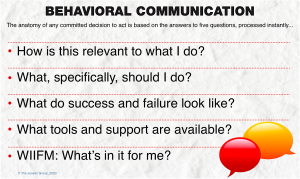We all know and experience how short attention spans are at work. Ridiculously short! (If you’re unclear how short yours is, take this test.)
But what about going beyond grabbing people’s attention… How do you communicate for behavioral change in an ADD World?
Since 1992, my teammates and I have conducted multiple lines of research as part of our Search for a Simpler Way study. Over 1,000,000 people interviewed and surveyed to date — all focused on all the dimensions of how we work, and how the future of work is changing everything. Part of that research has been on how to communicate for behavioral change.
We recently revisited that part of our 1990s findings and found the following even more true and pressing today, with so much information coming at us every second of every day.
When people have an exchange with someone (any exchange — emails, texts, one-on-one conversations, group meetings, group chats, teleconferences, videoconferences, etc. ), and they are asked to take action, participate, cooperate, or make a commitment… Their decision to…
- Do nothing or resist…
- Act, but only by complying… or…
- Act with full commitment…
…is based upon five separate criteria which buzz through their brains in nanoseconds. We labeled these criteria Behavioral Communication.
If you want someone to make a committed decision to act, you need to answer five key questions:
Each question is seeking clarity about specific dimensions of the behavioral changes required to get stuff done faster and better.
What fascinated us most when rolling out this tool was how cynical managers were. Most thought that the most asked questions would be 1) What’s in it for me? (“Everybody’s all about their WIIFM!”), and 2) What, specifically, should I do? (“Why can’t they think for themselves?!”)
Nuh-uh.
No one can achieve what their supposed to do without clarity. What, specifically, should I do? is about clarity of direction and instructions, which are sorely lacking from many managers today. And WIIFM? rarely ranked in the most immediate and most important questions employees asked.
The most asked, and least answered employee questions are: 1) What tools and support are available? This is the How do I get everything done? question. (“I already have too many To Dos, and you just piled one more thing on my plate?!?! What tools and support are available that are specifically designed to help me increase my personal output?! Not just the company’s.” And… 2) What do success and failure look like? Not just success or failure for the project or for the company — this is the How do I know, on my own, that I’m achieving what I need to? question. Despite all the emphasis on results and metrics in all companies, we have found that far too many managers are unclear when it comes to each individual’s understanding of their personal success or failure.
While this tool has been super helpful to many thousands of managers, we did find — with everyone’s short attention spans! — that all five questions were difficult to remember. So we created the mneumonic device, CLEAR— helping everyone communicate clearly.
When communicating for behavioral change, always be CLEAR.
• [C]onnect the communication to their current workload, making it relevant to what they’re currently focused on • [L]ist expected and immediate actions • Define [E]xpectations for their success. (Understanding what failure looks like is equally important) • Enhance their [A]bility to achieve success with training, tools, and support specifically designed to help them succeed • Ensure that there is some [R]eturn or benefit to them, not just to the company or the project.
After decades of testing, I can promise you that CLEAR is the shortest path you’ll take to behavioral change. CLEAR makes it easy for others to commit to act, not just comply.
One last promise: Want to skip over some of the five points so you can communicate faster? Go ahead! But here’s a guarantee… Instead of just one round of communication, your teammates will come back to you twice, thrice, up to five times — until their behavioral questions are answered. One communication or five, it’s your choice.
Editor’s Note: This article republished with the author’s permission with first publication on LinkedIn.


